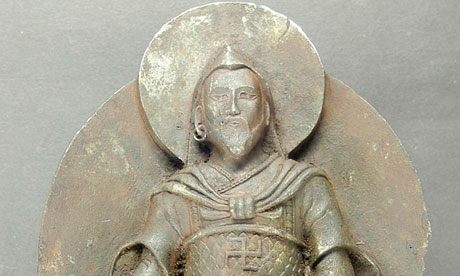
The Buddhist statue that a Nazi expedition
brought back from Tibet. Photograph: Elmar Buchner/AP
***
Relic taken by SS in 1930s analysed by researchers following reappearance at auction in 2007
A priceless Buddha statue looted by Nazis in Tibet in the 1930s was carved from a meteorite which crashed to the Earth 15,000 years ago, according to new research.
The relic bears a Buddhist swastika on its belly – an ancient symbol of luck that was later co-opted by the Nazis in Germany.
Analysis has shown the statue is made from an incredibly rare form of nickel-rich iron present in falling stars.
The 1,000-year-old carving, which is 24cm high and weighs 10kg, depicts the god Vaisravana, the Buddhist King of the North, and is known as the Iron Man statue.
It was stolen before the second world war during a pillage of Tibet by Hitler's SS, who were searching for the origins of the Aryan race.
It eventually made its way to a private collection and was hidden away until it was auctioned in 2007.
The new owner approached Dr Elmar Buchner of University of Stuttgart to unlock the secrets of the unusual carving's past.
Buchner's team of researchers from Germany and Austria dated it to a specific event in astronomy history when the Chinga meteorite fell in the border region of eastern Siberia and Mongolia between 10,000 and 20,000 years ago.
Tests proved the icon was made of a rare ataxite class, the rarest meteorite type found on Earth.
Gold prospectors discovered debris from the Chinga crash in 1913, but the fragment from which the statue was carved was collected centuries before.
Meteorites have long been heralded as acts of God across many cultures, and early knives and jewellery were often carved from the remnants of space rocks. But tracing their exact origins has proved difficult for scientists.
"We were quite astonished by the results," Buchner told the online journal Meteoritics and Planetary Science.
"If we are right that it was made in the Bon culture in the 11th century, it is absolutely priceless and absolutely unique worldwide," Buchner said.
"It is extremely impressive, it was formerly almost completely gilded – there is a great mystery represented by it."

***

No comments:
Post a Comment